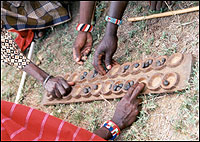Near the end of the 15th century the first Europeans
arrived on the Kenyan coast. In 1498, a Portuguese explorer named
Vasco de Gama stumbled upon the East African coast in search of
China. De Gama was initially rejected by the sultan at Mombasa although
his bitter rival, the sultan of Malindi welcomed the explorers.
Seven years later, the Portuguese onslaught on the region began.
By the 16th century, most of the indigenous Swahili trading towns,
including Mombasa, had been either sacked or occupied by the Portuguese
- marking the end of the Arab monopoly of Indian Ocean trade.

The
Portuguese settled in for a long period of harsh colonial rule,
playing one sultan off against another.The Portuguese were never
present in great numbers and they made no significant impressions
on the coasts of civilization. For the 200 years the Portuguese
spent in East Africa, the only significant impression they left
was the introduction of some crops like pineapples, bananas, maize
and cassava. A few words now used in Swahili originated from them.
Portuguese rule was harsh, unpopular, and economically debilitating
for the local people.
Throughout the 17th century, the Arabs attempted to reestablish
links with their East African outposts. This led to an ongoing series
of confrontations with the Portuguese to establish dominance. The
Omani ships prevailed and by the early 1700s, the Portuguese had
been routed completely. By 1720, the last remaining Portuguese left
for good leaving the East African coast again under Arab control.
Other than a cross overlooking the sea near Mombasa, virtually no
other trace of the hated Portuguese rule remains today. The 18th
century brought an emphasis on rebuilding the cities and reestablishing
the once thriving trade routes. Under the leadership of the Sultan
of Oman, Seyyid Said, the Arabs worked to regain economic and political
supremacy over the region. The island of Zanzibar quickly became
the center of a very lucrative trade in slaves and ivory from the
interior and spices from the island itself.

During this time, Arab slavers moved into the interior of Kenya
with the primary goal of exploiting rivalries between local tribes.
The Arabs encouraged the powerful groups to conquer their weaker
neighbors and sell them into slavery. The slaves were then forced
to the coast and on to Zanzibar to be traded. Both ivory and slaves
were hugely profitable and Zanzibar grew rich on the trade.
This pattern continued despite the public outrage in Europe demanding
an end to all slave trade. The report by explorer Dr. Livingstone
of a massacre of 400 Babenya people by slavers at Nyangwe, near
Lake Tanganyika, finally forced British Government. Eventually,
the British brought their forceful anti-slavery message directly
to the Sultan Barghash of Zanzibar, as they established a consulate
at his court. After years of pressure, the Sultan finally was forced
to sign a treaty banning the slave trade in 1873.



